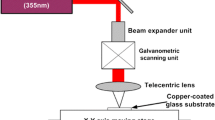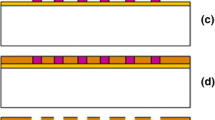Abstract
Induction efficiency is the evaluation index for measuring the induced voltage of a wireless-sensing module, and this index is affected by the electric properties, shape, number, and position of inductances. In this study, indium–tin oxide with a thickness of 30 nm was coated on a glass substrate to fabricate a planar square spiral inductor (PSSI), and patterns were then ablated using a UV laser with a wavelength of 355 nm. Single and array patterns with different dimensions were designed to investigate the variation of induction efficiency. The results indicated that the 3 × 3 PSSI array ablated at a frequency of 100 kHz and that a scanning speed of 1000 mm/s had the highest induction efficiency of 6.4 %, which was 2.4 % higher than that of PSSIs that ablated at other processing parameters. The induction efficiency could be enhanced, but the uniformity of sensing decreased as the array number decreased, and the highest induction efficiency of 10 % and highest variation of 7.2 % were caused by position deviation, which was obtained from a single pattern. In addition, the induction efficiency of 3.2 % was obtained from the 4 × 4 array pattern, and the variation caused by the position was controlled to less than 0.8 %. The results showed the specific relationship among the dimensions, number of patterns, and induction efficiency. The designed inductances can be applied to micro wireless-sensing modules in the future.











Similar content being viewed by others
References
J. Yick, B. Mukherjee, D. Ghosal, Comput. Netw. 52, 2292 (2008)
C. Buratti, A. Conti, D. Dardari, R. Verdone, Sensor 9, 6869 (2009)
G. Rezazadeh, A. Keyvani, S. Jafarmadar, Measurement 45, 580 (2012)
D.C. Abeysinghe, S. Dasgupta, J.T. Boyd, H.E. Jackson, Sensor 9, 6200 (2009)
J.L.M. Rupp, U.P. Muecke, P.C. Nalam, L.J. Gauckler, J. Power Source 195(9), 2669 (2010)
T. Sato, H. Tomita, A. Sawabe, T. Inoue, T. Mizoguchi, M. Sahashi, IEEE Trans. Magn. 30(2), 217 (1994)
M. Schaefer, J. Holtkamp, A. Gillner, Synth. Met. 161, 1051 (2011)
C.B. Aronld, H. Kim, A. Pique, Appl. Phys. A 79(3), 417 (2004)
H. Yu, H. Shin, M. Lee, Curr. Appl. Phys. 11, 179 (2011)
C.C. Yang, H.Y. Tsai, C.C. Yang, W.T. Hsiao, K.C. Huang, Appl. Phys. A 117(1), 69 (2014)
T. Gotz, M. Stuke, Appl. Phys. A 64(6), 539 (1997)
R.P. Ribas, J. Lescot, J.L. Leclercq, J.M. Karam, F. Ndagijimana, IEEE Trans. Microw Theory Tech. 48(8), 1326 (2000)
N. Klejwa, R. Misra, J. Provine, R.T. Howe, S.J. Klejwa, J. Vac. Sci. Tech. B 27, 2745 (2009)
S.S. Mohan, M.D.M. Hershenson, S.P. Boyd, T.H. Lee, IEEE J. Solid-State Circuit 34(10), 1419 (1999)
A.R. Lopez, IEEE Antennas Propag. Mag. 48(4), 28 (2006)
H.M. Greenhouse, IEEE Trans. Parts, Hybrids Packag. 10(2), 101 (1974)
S.F. Tseng, W.T. Hsiao, K.C. Huang, D. Chiang, Appl. Surf. Sci. 257, 8813 (2011)
G. Vandevoorde, R. Puers, Sens. Actuators A Phys. 92(1), 305 (2001)
Acknowledgments
This work was supported in part by the Ministry of Science and Technology, Taiwan, under Grants MOST 104-2622-E-007-008-CC2 and MOST 104-2622-E-492-012-CC3.
Author information
Authors and Affiliations
Corresponding author
Rights and permissions
About this article
Cite this article
Yang, CC., Hung, MW., Tsai, HY. et al. Planar square spiral inductor generated through indium–tin oxide film removal by using UV laser ablation. Appl. Phys. A 122, 441 (2016). https://doi.org/10.1007/s00339-016-9997-7
Received:
Accepted:
Published:
DOI: https://doi.org/10.1007/s00339-016-9997-7




